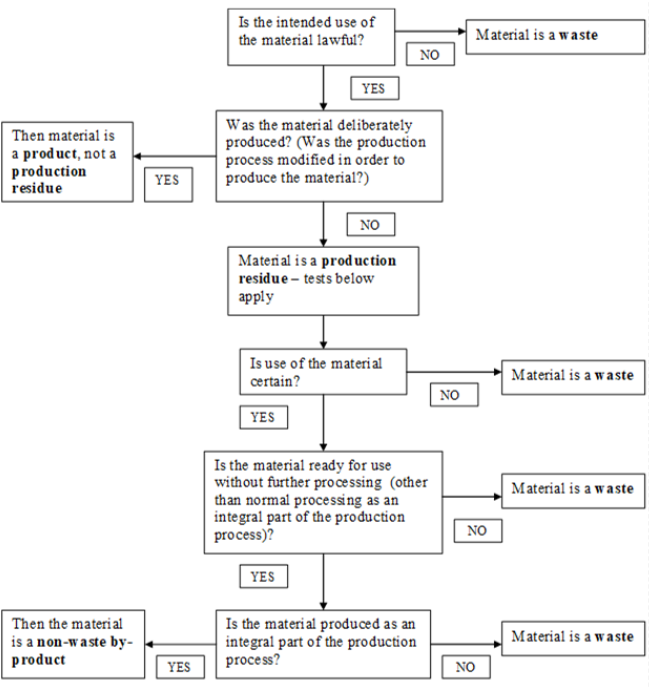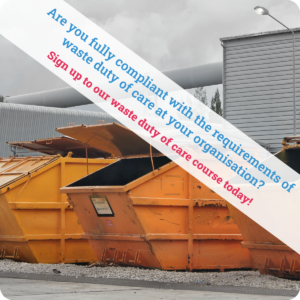Bitesize webinar
Do you need help understanding what waste transfer notes are and how to complete them?
Listen to one of our short and simple 20-minute webinar on waste transfer notes in Scotland.
Kerry Hammick, one of our experienced consultants, will talk you through:
- what waste transfer notes are and why we need them;
- what information is required on a waste transfer note;
- how to correctly complete a waste transfer note; and
- what annual waste transfer notes are and how to use them.
Common Definitions
Waste: Anything which you decide to, or are required to, throw away.
Hazardous waste: Waste is generally considered hazardous if it (or the material or substances it contains) are harmful to humans or the environment. Examples of hazardous waste include:
- asbestos;
- chemicals, such as brake fluid or print toner;
- batteries;
- solvents;
- pesticides;
- oils (except edible ones), such as car oil;
- equipment containing ozone depleting substances, like fridges; and
- hazardous waste containers.
Waste transfer note: A waste transfer note (WTN) is a legally required document which must be completed for all transfers of non-hazardous waste to another party. The format of a WTN must conform to the requirements laid out in Part 9 of The Waste (England and Wales) Regulations 2011.
Consignment note: A consignment note, or hazardous waste consignment note (HWCN) is a legally required document that details the transfer of hazardous waste from one party to another. The note must be prepared before any hazardous waste is moved and is required for all movements of hazardous waste. The format of a HWCN must meet the requirements set out in Schedule 1 of The Hazardous Waste (England and Wales) (Amendment) Regulations 2016.
Producer: Any person whose activities produce waste.
Holder: The waste producer or the legal person in possession of the waste.
Carrier: A person who collects or carries waste. A carrier must be registered with the Environment Agency in England or Natural Resources Wales in Wales.
Dealer: Any person that buys waste with the aim of subsequently selling it (including where they don’t take physical possession of the waste).
Broker: Any person that arranges waste transportation and / or the management of waste on behalf of another party, e.g. local authorities contracting out waste services to another firm.
Transferor: The current holder of the waste.
Transferee: The person receiving the waste.
Consignee: A person who receives hazardous waste to recover or dispose of it. The consignee must have an appropriate environmental permit or waste exemption in place in order to accept the waste.
Consignor: A person who causes the waste to be removed; this can be the producer, the holder or an agent acting with authority from the producer or holder of the hazardous waste.
FAQs
A waste transfer note (WTN) is a legally required document which must be completed for all transfers of non-special waste to another party. The format of a WTN must conform to the requirements laid out in section 3 of The Environmental Protection (Duty of Care) (Scotland) Regulations 2014.
A WTN can be issued to cover a particular collection, or for multiple collections of the same waste type, from the same site, by the same waste carrier over a maximum period of one year (a ‘season ticket’).
WTNs are not required by an occupier of domestic property for the removal of household waste produced on the property.
A WTN is a legally required document for non-hazardous waste. When hazardous waste is moved, it must be accompanied by correctly completed paperwork called a consignment note, or hazardous waste consignment note (HWCN). The note must be prepared before any hazardous waste is moved and is required for all movements of hazardous waste. The format of a HWCN must meet the requirements set out in Schedule 1 of The Hazardous Waste (England and Wales) (Amendment) Regulations 2016.
An annual WTN or ‘season ticket’ is a single WTN that covers a series of non-hazardous waste transfers. The annual WTN can last up to one year and be used for regular transfers of the same type of non-hazardous waste with the same waste carrier from the same site. If you have several sites serviced by the same carrier with the same types of waste collected, they can be listed in a schedule to the annual WTN. It must be clear on the WTN what period it covers.
You should also keep a record of the collection times and the quantity of waste collected each time. A good way to do this is to get a delivery ticket from the waste carrier for each load collected stating when the collection took place and how much was collected.
Waste needs to be disposed of legally and correctly to protect people and the environment. It is a legal requirement that WTNs are completed for all transfers of waste to another party. WTNs allow the regulator to understand what wastes are being generated and how they are being disposed of and / or recovered. They provide a clear auditable paper trail from when the waste is produced to when it is disposed of and can help to evidence that a business has met its statutory duty of care.
WTNs are legally required for all transfers of non-hazardous waste to another party.
A WTN must be signed and dated by the transferor (usually the producer or holder of the waste) and the transferee (the person receiving the waste).
Paper or electronic copies of WTNs are acceptable. For non-hazardous waste in England and Wales you can use:
- ‘Edoc’ (electronic duty of care) – a free national electronic duty of care system that creates, shares, signs and stores waste transfer notes and season tickets for you online.
- A paper WTN – a form to fill in or you can use alternative documentation, e.g. an invoice, as long as it contains all the required information.
- An electronic WTN, as above.
For hazardous waste consignment notes, paper or electronic copies are also acceptable. However, the online Edoc system is not yet available for hazardous wastes. The Environment Agency and Natural Resources Wales provide a template consignment note. You can use your own consignment note but it must have all the same information fields as this one and be as near to the same format as possible.
It is a legal requirement to keep copies of all WTNs / waste transfer information for at least two years. Hazardous waste consignment notes must be retained for a minimum of three years.
- The law is very specific about what WTNs must contain, and it’s important that nothing is missed. The information required is:
- A description of the waste.
- Any processes the waste has been through.
- How the waste is contained/packaged.
- The quantity of waste (weight).
- The place and date of transfer.
- The name and address of both parties – producer and carrier.
- Details of the permit, licence or exemption of the person receiving the waste.
- The licence or registration number of the person handing over the waste, if they have a waste management licence or are a registered carrier of controlled waste.
- The appropriate European Waste Catalogue (EWC) code (codes used to identify waste as listed in the European Waste Catalogue, also referred to as LoW (List of Waste) or Waste Classification Code).
- The Standard Industry Code (SIC) of your business (a code which describes the nature of a company’s business).
- A statement that the waste hierarchy has been applied.
The Environment Agency and Natural Resources Wales provide a template WTN (in English and Welsh) which includes all of the required information. You can use alternative documentation, e.g. an invoice, as long as it contains all the required information.
The Environment Agency and Natural Resources Wales provide a template consignment note which is available in an electronic and paper version. You can use your own consignment note but it must have all the same information fields as this one and be as near to the same format as possible.
The Environment Agency’s public register allows checks to be carried out on waste carriers, waste exemptions and environmental permits in England. Simply select the register you wish to view, type in the company name (or you can use the address or permit number if you know it) and click ‘search’. You will then be able to see what authorisations your waste contractor has in place.
Natural Resource Wales’ public register allows checks to be carried out on waste exemptions and environmental permits in Wales in the same way that the Environment Agency’s register does above. Waste carriers licences in Wales can be checked used Natural Resources Wales spreadsheet of carriers, brokers and dealers.
It is good practice to request a copy of the environmental permit for the disposal / recovery site that your waste is being sent to. By doing so, you can check the EWC codes (codes used to identify waste as listed in the European Waste Catalogue, also referred to as LoW (List of Waste) or Waste Classification Code) the permit authorises to be accepted at that site are the same as those for the wastes being removed from your premises.
When a material is manufactured from non-waste materials, production residues are often unavoidable. The residue is either a waste or a non-waste by-product.
The residue is a by-product and not a waste when the material meets all of these conditions:
- It’s a result of a production process.
- It’s certain to be used, if there’s a contract between the producer and supplier or user, if there’s a definite market for it, if it fulfils the same specifications as other products on the market, or if there’s an economic benefit for the producer.
- It can be used directly, with no further processing before it’s used – you can carry out normal industrial practices, for example mechanically modifying the size or shape, but you can’t carry out a waste activity or operation on it.
- It’s produced as an integral part of the production process – but it doesn’t necessarily have to be made ready for use at the same place where the residue is produced.
- It has a lawful use and meets relevant product and environmental and health protection requirements, for example it is free of contaminants and won’t lead to overall adverse environmental or human health impacts.
Common examples include:
- Spent brewer’s yeast used as a food spread.
- Uncontaminated sawdust from a sawmill used as animal bedding.
- Uncontaminated natural soil suitable for use that doesn’t require treatment and is certain to be used in a lawful way.
The decision tree on the next page can help in determining if something is a waste or a by-product.

Find out how our Legal Registers work
No obligation demo to help you understand how it works and how your business can use it
